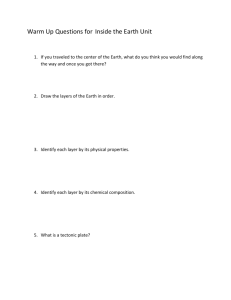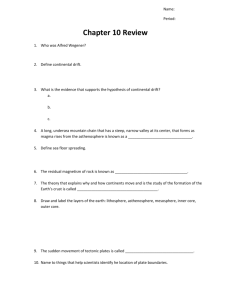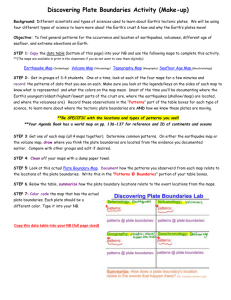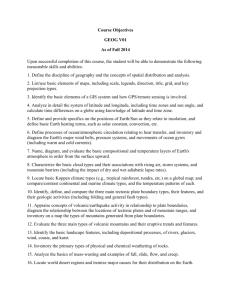ANGEO_LearningObjectives-CausalPrinciples_ Nov11 DS
advertisement
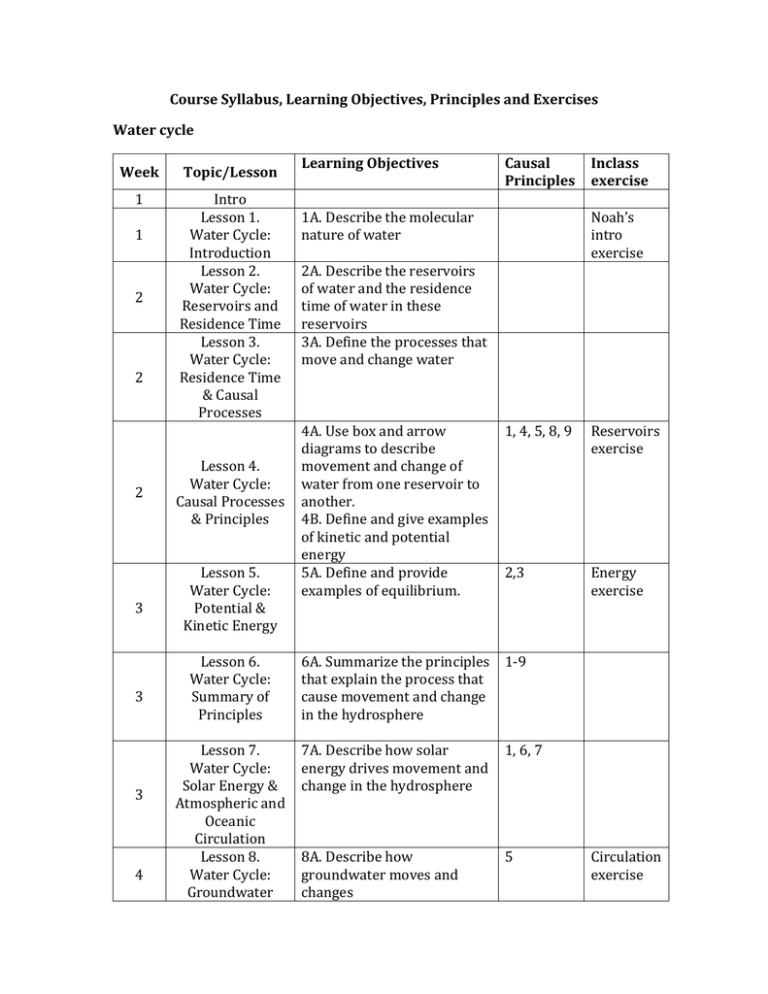
Course Syllabus, Learning Objectives, Principles and Exercises Water cycle Week Topic/Lesson 1 Intro Lesson 1. Water Cycle: Introduction Lesson 2. Water Cycle: Reservoirs and Residence Time Lesson 3. Water Cycle: Residence Time & Causal Processes 1 2 2 2 3 3 3 4 Lesson 4. Water Cycle: Causal Processes & Principles Lesson 5. Water Cycle: Potential & Kinetic Energy Lesson 6. Water Cycle: Summary of Principles Lesson 7. Water Cycle: Solar Energy & Atmospheric and Oceanic Circulation Lesson 8. Water Cycle: Groundwater Learning Objectives Causal Principles 1A. Describe the molecular nature of water Inclass exercise Noah’s intro exercise 2A. Describe the reservoirs of water and the residence time of water in these reservoirs 3A. Define the processes that move and change water 4A. Use box and arrow diagrams to describe movement and change of water from one reservoir to another. 4B. Define and give examples of kinetic and potential energy 5A. Define and provide examples of equilibrium. 1, 4, 5, 8, 9 Reservoirs exercise 2,3 Energy exercise 6A. Summarize the principles 1-9 that explain the process that cause movement and change in the hydrosphere 7A. Describe how solar energy drives movement and change in the hydrosphere 1, 6, 7 8A. Describe how groundwater moves and changes 5 Circulation exercise 4 4 5 5 6 Lesson 9. Water Cycle: Evidence for Past Changes Lesson 10. Water Cycle: Future Changes 9A. Describe evidence for past, large-scale changes in the water cycle. 10A. You will be able to state some predicted consequences for the water cycle of continued global warming. 11A. You will be able to place an ethical decision into one or more of the five categories. Lesson 11. Water Cycle: Ethics Lesson 12. Water Cycle: Responding to Freshwater Crisis test Plate Tectonics 7 I suggest both classes do an activity on ethics. I could develop an analogy exerciseare the ethical considerat ion about climate change the same as those about XXX. 12A. You will be able to propose a reasonable response to water shortages in the southwestern region of the United States. Lesson 13. Water Cycle: Review Lesson 14. Plate Tectonics 6,7,8,9 a. Describe plate tectonic theory and the kinds of evidence that supports the theory 7 7 8 8 8 9 Lesson 15. Plate Tectonic Boundaries Lesson 16. Buoyancy and Convection Lesson 17. Processes at Plate Boundaries Lesson 18. Rock Cycle, part I a. Describe the interior of the earth- inner core, outer core, mantle, crust, asthenosphere and lithosphere b. Draw the plate boundaries a. Explain buoyancy and how it causes tectonic plates to move b. Describe the role of thermal and gravitational energy in convection. a. Explain why most earthquakes occur at plate tectonic boundaries b. Explain why most magmas, and therefore, volcanoes form at plate boundaries. 1,5, 7 a. Define igneous, sedimentary and metamorphic rocks b. Describe the roles of temperature, pressure and water in melting a. Explain how buoyancy causes uplift. 3,4 a. List the major calcium reservoirs b. Calculate the residence time of Ca in the oceans and in limestones c. Describe the movement and change of Ca from 3,4 4,5, 7 7 Lesson 19 Rock Cycle, Part II Lesson 20. Calcium Cycle, Part I Convection exercise Buoyancy exercise Or metamorp hism exercise? calcium silicate to calcium carbonate and back again to calcium silicate with reference to the following equation. CO2 + H2O + Ca-silicate CaCO3 + silica + clay Note: you do not need to memorize this equation but you do need to be able to describe what it represents. 9 9 10 Lesson 21. Calcium Cycle, Part II Lesson 22. Carbon and the rock cycle a. Describe calcium dissolution and precipitation of calcium carbonate. b. List 2 similarities and 2 differences between the calcium cycle and the water cycle. 3,4 Chemical energy exercise a. Describe how oil, gas 1 thru 9 and coal form. b. Use a box and arrow diagram to trace organic carbon from the biosphere through the lithosphere. test Lesson 23. Review Carbon Cycle 11 Lesson 24. Introduction to Global Climate Change a. Describe the earth’s energy balance. b. Explain why the term “greenhouse” is not a perfect analogy for how 6 Greenhou se analogy exercise CO2 helps keep our planet warm. 11 11 12 12 13 Lesson 25. Carbon: Matter and Reservoirs, Part I Lesson 26. Carbon: Matter and Reservoirs, Part II a. Describe the common carbon containing molecules in each reservoir. b. Describe the process that move and change carbon from one reservoir to another. a. Use information on fluxes and reservoir sizes to calculate residence times of carbon in various reservoirs a. Give an example of how 6 of the of the 10 principles can be used Lesson 27. to predict climate Principles that move change. and change matter b. Give examples of positive and negative feedback in the climate system. a. Define abrupt climate change and explain some of the evidence that it has occurred in the past. Lesson 28. b. Explain why scientists Evidence of Past think positive feedback Climate Change plays a role in abrupt climate change. c. Describe evidence scientists use to infer paloeclimates. a. State how changes in Lesson 29. global climate are Predicting the expected to affect U.S Future b. Draw a graph comparing change with feedback to linear 1,2,3,4,8,9 Principles 1-10 Positve and negative feedback exercise 4, 10 10 Predictio n from principles exercisethis will be about change without feedback. c. Explain how climate models are constructed and why this leads to uncertainty in predictions. 13 13 14 15 Lesson 30. Climate Change Ethics Lesson 31. Are there alternatives to the climate disaster? Lesson 32. Review Lesson 33. Course Review predictio ns of stock market trends versus CO2 trends. a. Describe how the discount model for determining the value of future goods is similar to the model we used to predict costs of the increase in global carbon emissions. a. Identify 3 main approaches we might use to address global climate change. b. Describe problems and/or reasons to doubt each approach 1,6,9 Geoengin eering (with SO2) vs eruption exercise


